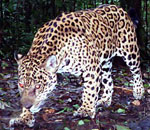Wildlife biologists in Ecuador’s Amazon jungle, seeking to census populations of animals as oil exploration and development pressure grows, have used camera traps to take photographs of rarely seen species, including jaguars and short-eared dogs. The New York-based Wildlife Conservation Society is conducting the research, which found five times more jaguars in remote areas than in regions where roads and other development have led to an increase in poaching and bushmeat hunting. In the past two years, biologists have taken 75 photographs of jaguars, which can be individually identified by their unique pattern of spots. The camera traps also have snapped pictures of white-lipped peccaries, a major prey species for jaguars, and short-eared dogs, which are related to wolves and foxes.
In Ecuadorian Amazon, CameraCaptures Images of Jaguars and Rare Dogs
More From E360
-
Energy
To Feed Data Centers, Pennsylvania Faces a New Fracking Boom
-
SPACE
Scientists Warn of Emissions Risks from the Surge in Satellites
-
WILDLIFE
A Troubling Rise in the Grisly Trade of a Spectacular African Bird
-
MINING
In Myanmar, Illicit Rare Earth Mining Is Taking a Heavy Toll
-
INTERVIEW
How Batteries, Not Natural Gas, Can Power the Data Center Boom
-
ANALYSIS
As U.S. and E.U. Retreat on Climate, China Takes the Leadership Role
-
Solutions
From Ruins to Reuse: How Ukrainians Are Repurposing War Waste
-
ANALYSIS
Carbon Offsets Are Failing. Can a New Plan Save the Rainforests?
-
Energy
Facing a Hostile Administration, U.S. Offshore Wind Is in Retreat
-
Biodiversity
As Jaguars Recover, Will the Border Wall Block Their U.S. Return?
-
WATER
An E.U. Plan to Slash Micropollutants in Wastewater Is Under Attack
-
INTERVIEW
This Data Scientist Sees Progress in the Climate Change Fight
